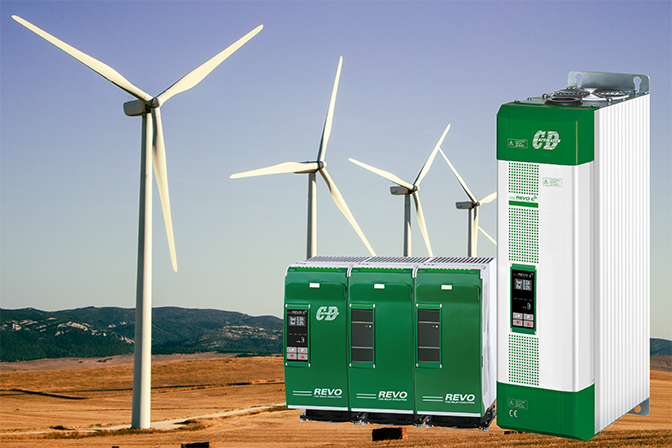Wind energy is more efficient and more widely used than solar energy and can be defined as the kinetic energy produced by the movement of air over the earth’s surface, between areas of high and low pressure.
As current growth trends predict, this green energy should, by 2030, cover 20% of global electricity demand, resulting in a reduction in CO2 emissions of more than 3 billion tonnes per year.
Power control in wind power plants
The function of the power control system of wind turbines is to optimise and regulate the power output as the wind speed changes.
There are two types of power control systems:
- Pitch control: This is an automated form of control, which increases or decreases the surface area exposed to the wind and thus modifies the aerodynamic efficiency of the blades.
- Stall control: the blades are constrained to the hub, so the aerodynamic design of the blades is used for power control, or the deformation of the small blades at high wind speeds is exploited.
In addition, turbines are equipped with braking systems, which slow the rotor’s rotational speed down to the maximum tolerated wind threshold (cut-out wind speed). Once the cut-off speed has been exceeded, the turbine stops producing energy and becomes safe by stopping the rotor completely or by misaligning the rotor axis or the blade rotation axis.
Wind turbine systems use the wind to turn a turbine to generate electricity. Excessively cold temperatures and ice build-up can be detrimental to turbine operation due to accumulated weight on the turbines, bearing wear due to shaft imbalance and even blockage.
CD Automation‘s thermoelectric technologies provide the means to ensure that wind turbines continue to operate at maximum efficiency despite extreme conditions:
Where wind turbines need frost protection, silicone laminate heaters, heat traces or comfort heaters can be used inside the nacelles or turbine blades to prevent ice build-up or freezing. In addition, small immersion heaters are ideal for pre-heating lubrication oils that allow wind turbines to operate efficiently, even in colder climates.
REVO C product family
CD Automation is able, through its REVO C, to manage the excess energy discharge system of wind turbines. Let’s take a detailed look at these Units that helps companies that use them to optimise costs and reduce space and wiring.
REVO C is a highly reliable universal power controller with an advanced microprocessor that makes it universal and fully configurable via software; particular attention was paid to connectivity with the most popular Field Bus. In addition, UL certification is available for sizes 800A to 2100A (1PH and 2PH) and 600A to 2100A (3PH), Short Circuit Current Rating 100kA.

Here are the product details:
- REVO Connect is fully Software configurable.
- Universal Input: The standard analog inputs 4:20mA and 0:10V and SSR Configurable via Software.
- All types of firing mode available: Half Cycle, Single Cycle, Burst Firing, Delayed Triggering, Phase Angle and Soft Start.
- OLED display on front Unit: This display give better operator interface and delivers user-friendly intuitive messages.
- Universal Control Mode: Current, Voltage, Power, Open Loop.
- Integrated Data Logging with Storage on SD Memory Card with programmable Logging Intervals.
- High precision measurement (True RMS Value for V, I and VxI) ≤1%.
- Integrate Fuse: This reduce labor and space and gives the possibility to use a part of fan cooling air to reduce the temperature of semiconductor fuses and reduce the mounting space inside the cabinet.
- Greater protection in case of Short Circuit: 100 KA Short Circuit Current rating (SCCR) up to 600V.
- Generous sizing of Thyristors and Thermal Parts using hight efficency Heatsink.
- Wide range of communication protocols: Control board has been engineered to plug on it different Field Bus boards: Modbus RTU, Ethernet TCP, Profibus, Profinet.
- The USB port on the front of the unit for configuration allows the REVO C to be configured easily and safely, as the unit is powered by the USB port itself (no load and auxiliary voltage required).
- Energy Counter Totalizer: This is available as an option and can be useful to define the cost per hour of heating system.
- Fully compatible with REVO M and REVO CL serie: This is an important feature because allows to substitute old REVO with REVO C The number of terminal blocks is the same to facilitate the substitution.
- Integrate Load Analyzer: This is an important feature that can help the operator for troubleshooting problems. This is a Real Wave Form Load Monitoring.
REVO C allows simpler configuration, with less wiring and lower hardware cost than conventional SSRs or contactors: feedback from its use in wind energy has been excellent.
CD Automation offers a wide range of some of the world’s most sophisticated products for loads up to 3000KW in single-phase, two-phase and three-phase versions, Thyristor Power Controllers (SCR Power Controllers), Solid State Relays, and Temperature Controllers.
CD Automation has created a competence centre to support our partners in electrifying applications, reducing consumption, complexity and improving power quality in thermal processes in the field of renewable energy.

Do you work in the wind energy sector and are you interested in knowing more about CD Automation’s offer? Contact us! A team of experts is at your disposal!





